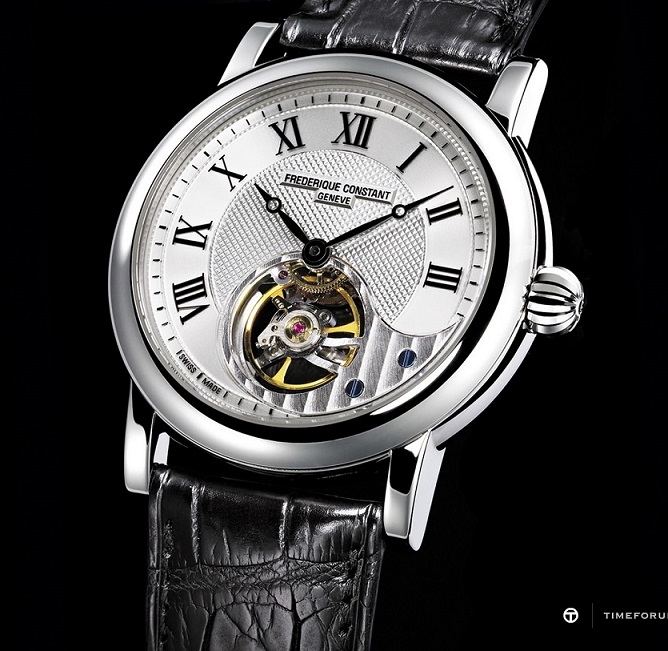Frederique Constant, a watchmaker based in Geneva, Switzerland, which stands for ‘Accessible Luxury’, celebrated its 30th anniversary last year. Couple Peter Stas and Aletta Stas dream of offering high-quality Swiss-made watches at an affordable price, and with the meaning of inheriting the watchmaking heritage of their predecessor, Frédérique, the name of their wife Aletta’s great-grandfather. and her husband Peter’s great-grandfather, Constant, respectively, and founded Frederick Constant in 1988. After that, the first prototype was completed in 1991, a total of six types of watches were released the following year, and the first Heart Beat watch released in 1994 became a so-called jackpot, laying the foundation for dazzling growth.
The concept of exposing key parts of a mechanical movement (balance wheel and balance spring, etc.) with an open workd dial surface through a simple time-only watch rather than an expensive tourbillon was first introduced by Frederick Constant at the time. However, the fact that several brands, stimulated by Heartbeat’s great success because they did not apply for a patent, rushed to borrow this concept, is a publicly known secret in the industry.

The early 1990s, when the heartbeat watch appeared, were a new opportunity for Swiss watchmakers. This is because the craze of quartz watches that hit the 1970s and 1980s has subsided to some extent, and more and more people are missing the vitality and analog charm of mechanical watches that cannot be felt in quartz replica watches. Following the first heartbeat model (Ref. FC-310M36), in 1995, the following year, the first women’s heartbeat collection was released. With the addition of models, the Heartbeat series has been enriched every year.
And with the release of the first Manufacture Manual Heartbeat Model (Ref. FC-910MC4H6), completed after about three years of research and development in 2004, Frederick Constant stepped forward as a manufacturer in earnest. Since then, in 2005, the FC-915 added moon phase and date (pointer type) functions, the first automatic version of Heartbeat Manufacture FC-930 in 2006, and the FC-935 that added moon phase and date in 2007, new in-houses every year. The development of the caliber made a technological leap forward.
In 2006, Frederic Constant completed a vertically integrated modern manu- facture with 3,200 square meters (about 968 pyeong) and four stories high in Plan-les-Ouates, outside Geneva, Switzerland. In addition, a second manufactory with a size of 3,000 square meters is currently being built on the adjacent site.
But it didn’t stop there, Frederick Constant took the unprecedented spotlight at Baselworld 2008 with an unexpected limited edition watch. It was the first of its kind to introduce the Manufacture Tourbilon model with the in-house automatic tourbillon caliber FC-980. The emergence of the Manufacture Tourbillon is noteworthy in two major ways. First of all, Frederick Constant, who had a family with a tourbillon-like but non-tourbillon collection such as the Heartbeat series, first challenged the realm of the tourbillon, a traditional gravity-offset complication, and the state-of-the-art silicium escape using semiconductor wafer manufacturing technology. The mere fact of introducing the Silicium escapement wheel was enough to attract attention.
Frederic Constant’s silicium (silicon) escapement wheel manufactured by applying the so-called Deep Reactive Ion Etching (DRIE) technology used in the manufacture of advanced semiconductor wafers. The design that embodies the brand crest is a point in its own way. It is possible to manufacture about 250 silicium escape wheels with a thickness of 0.5 mm on a single 100 mm wafer… It has a structure that does not require lubrication due to its excellent heat resistance and durability in an ultra-light material, and is not significantly affected by operating stability due to changes in vibration angle. Of course, it can withstand high magnetic field environments!
About 80 parts that make up the tourbillon cage are manufactured with a precision of 1-2 microns (0.001-0.002mm) using ultra-precision CNC machines from Planlewat Manufacture. However, since even such high-precision parts do not have the same weight distribution 100%, Frederic Constant added weight-shaped parts based on its proprietary smart weight balancing system. The center of gravity can be adjusted by adding or adjusting a small ring at the bottom of the screw that holds the weight, which also affects the rotational force and isochronousness of the entire cage.